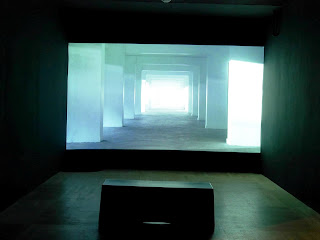Two giant bent cigarettes lie on the ground, the masking tape around it reminding one not to touch this glossy object. Look hard at Robert Zhao Renhui’s photographs and the camouflage falls away. Unlike Chris Chong Chan Fui’s botanical drawings, which the exhibition catalogue informs are actually artificial flower renderings. An overhead projection shows a rope floating in the sea, or if one prefers to sit, there is a six-minute video focusing on the far end of a void deck in Singapore’s ubiquitous apartments. A row of small photographs capture cineplexes from a bygone era, while colourful furniture and posters are displayed nearby. The gallery entrance is painted in yellow and black diagonals like a barricade, and the only available wall text is a description of a national flag. This is contemporary art, as curated in Singapore.
 |
| Installation view of Perception3 - Terminus (2008) [picture taken from Michael Lee's Facebook album] |
As “…an exhibition that commemorates neighbourly ties and shared affinities”, it is difficult not to feel comfortable with the show’s polished execution. Despite Singapore’s well-known cultural propaganda efforts, it is a mistake to charge the exhibiting artists as complicit to this cunning agenda. Given that the chosen Malaysian artists are recommended by the same source, comparing artworks from both nationalities also become irrelevant. Focus on the commonality, then. Detected in many artworks is a deeply-coded subversion, that manifests the issues of people living under authoritarian societies. Uneventful moving pictures in Charles Lim’s “Sea State” series, and ‘Terminus’ by Perception3, offer meditative scenes for viewers to reflect upon nation-defining spaces. Nearby, Yee I-Lann’s “Orang Besar” series draw significant potency, every time a VIP looks at it.
 |
| Malaysian and Singaporean Prime Ministers looking at Yee I-Lann' - The Orang Besar Series: YB #1-10 (2010) [picture taken from The Straits Times news portal] |
Ironically, exhibits displayed under the Culture banner, are the least attractive. Graphic design and role play odes to Malay cinema add little to its source, while a couple of digital photo frames and typed poems present weak attempts at expressing stirring truths. Unassuming displays by Michael Lee and Vertical Submarine remind one about seeing art within the context of its space, which leads to a re-looking of Chun Kai Feng’s ‘Nobody to Hold’. Having encountered it twice in Singapore and dismissed it each time, this glossy sculpture would not be out of place as a bench in a Malaysian public park. Bending a cigarette at its butt reduces its potency; doing a double and laying it on the ground like litter, recalls clean streets (and its metaphorical synonym with that) of the island state. That it is constructed from industrial materials, only adds to its artful lustre.
 |
| Chun Kai Feng - Nobody to Hold (2013) |
chi too’s long-titled book shelves, and Heman Chong’s 148-words ‘The Singapore Flag’, stand out for its concealed materiality. In the former’s wonderful constructs, formal characteristics like line and colour are embedded with additional dimensions like physical divide and shadows. Overlapping alphabets in the latter depict the forceful nature of an official description, thus granting yet limiting too the power of one formulated statement. When viewed together, these artworks invoke strong metaphorical interpretations “…for the pondering and understanding of ideas pertaining to nation, nationhood, and nationality”. Building bilateral relations via shared culture seems like an agreeable diplomatic strategy, until one realises that nations need to utilise culture as a unifying factor, while culture do not need nations for anything.
"Bendera Malaysia mengandungi 14 jalur merah dan putih (melintang) yang sama lebar bermula dengan jalur merah di sebelah atas dan berakhir dengan jalur putih di sebelah bawah, tanda keanggotaan yang sama dalam persekutuan 13 buah negeri- Johor, Kedah, Kelantan, Melaka, Negeri Sembilan, Pahang, Pulau Pinang, Perak, Perlis,Sabah, Sarawak, Selangor dan Terengganu dan Kerajaan Persekutuan. Bahagian yang berwarna biru tua di atas sebelah kiri membawa ke bawah hingga atas jalur merah yang kelima itu maknanya perpaduan rakyat Malaysia. Bahagian biru tua itu mengandungi anak bulan tanda Agama Islam - agama rasmi Malaysia. Bintang pecah 14 itu tanda perpaduan 13 buah negeri dan Kerajaan Persekutuan. Warna kuning pada anak bulan dan bintang itu ialah warna Diraja bagi Duli-duli Yang Maha Mulia Raja-raja."
- Description of the Malaysia flag, from the Jabatan Penerangan Malaysia web portal
| Close-up snapshots of Heman Chong - The Singapore Flag (2015) |